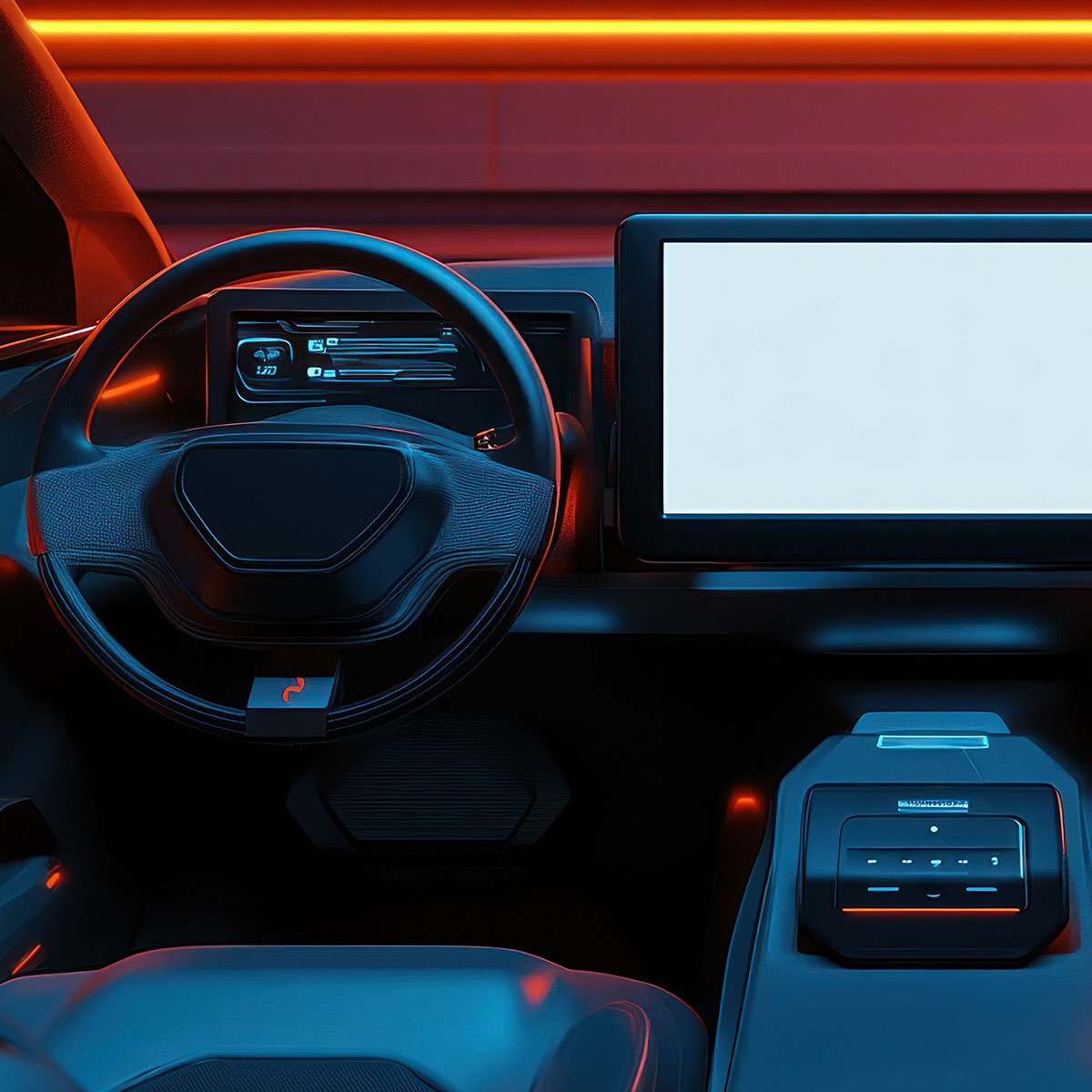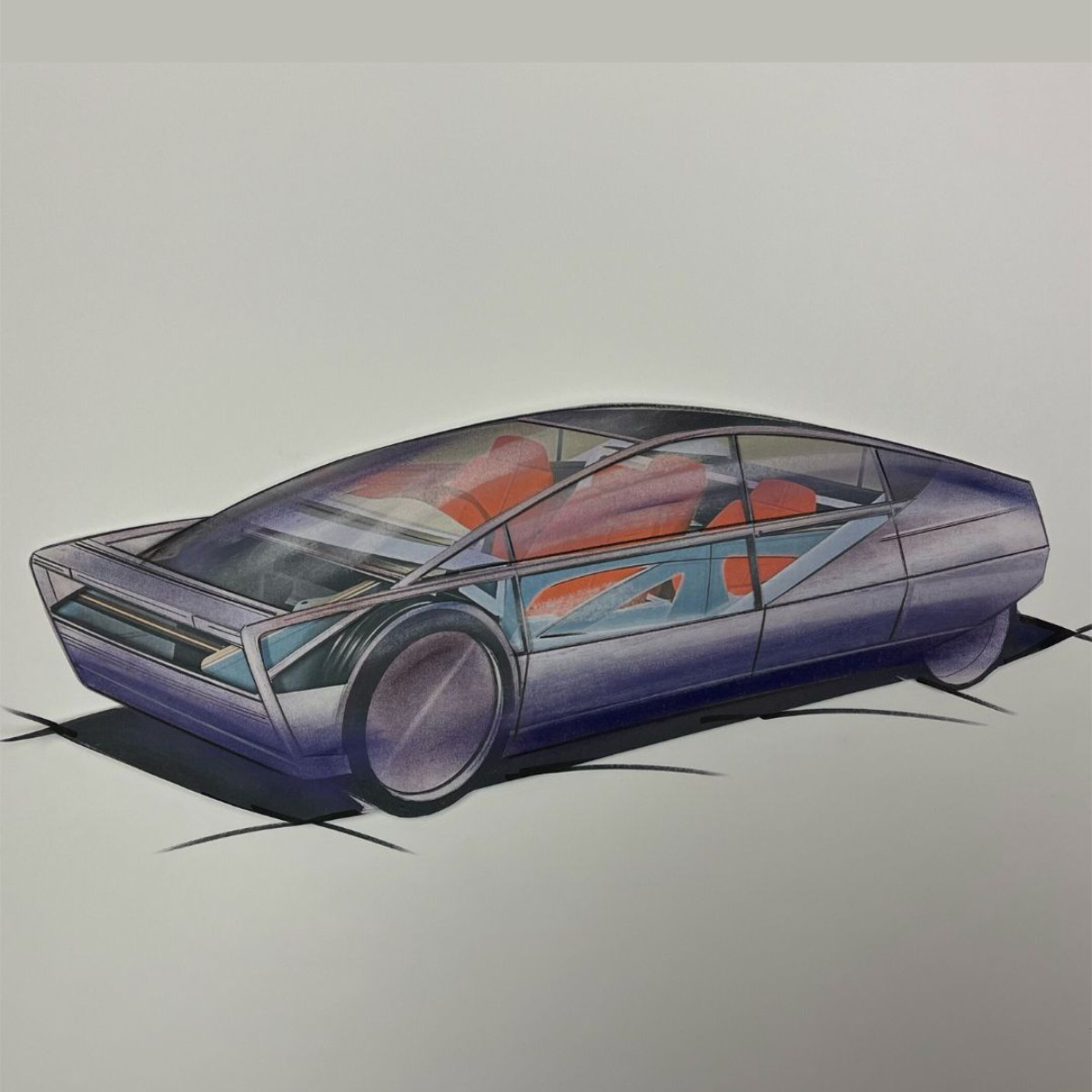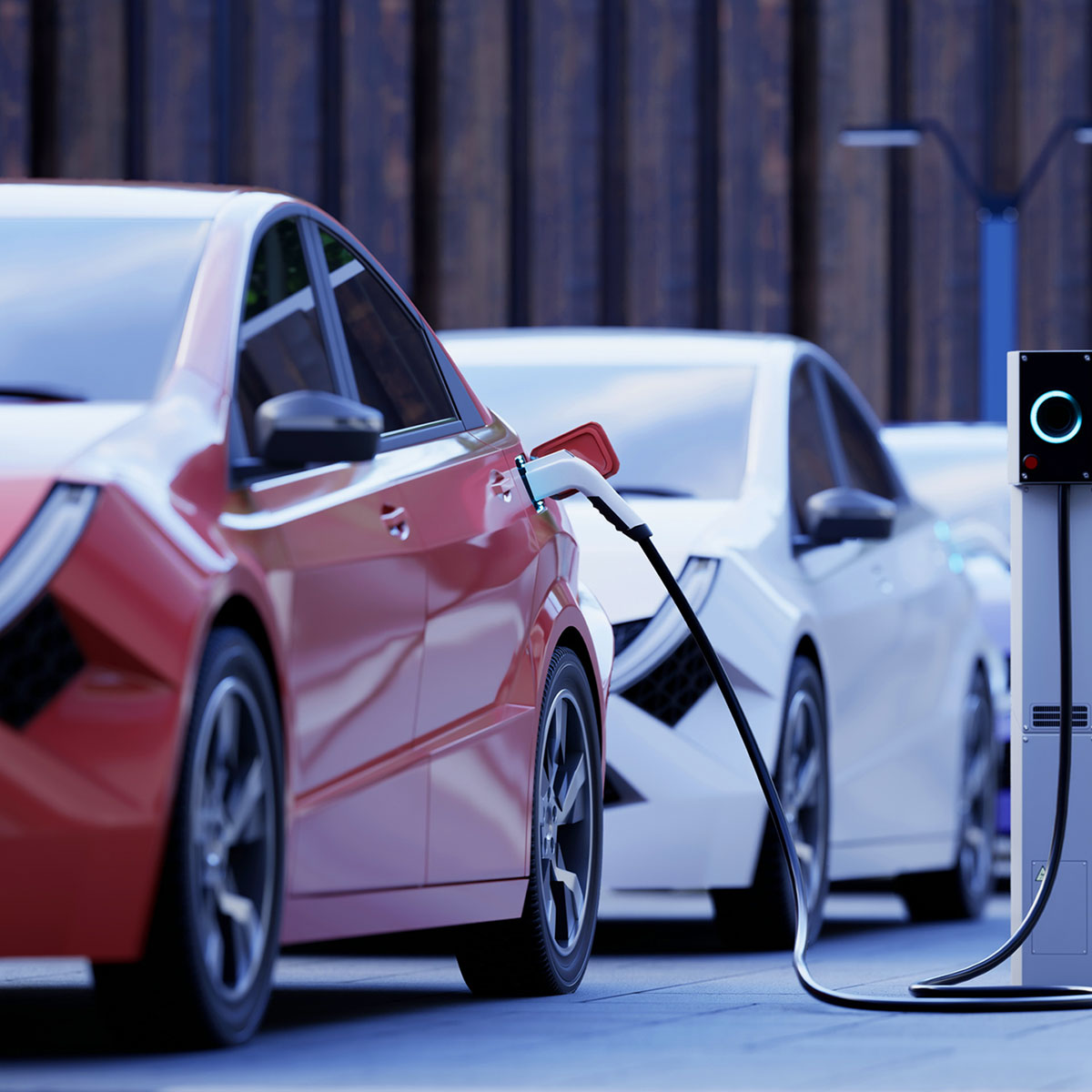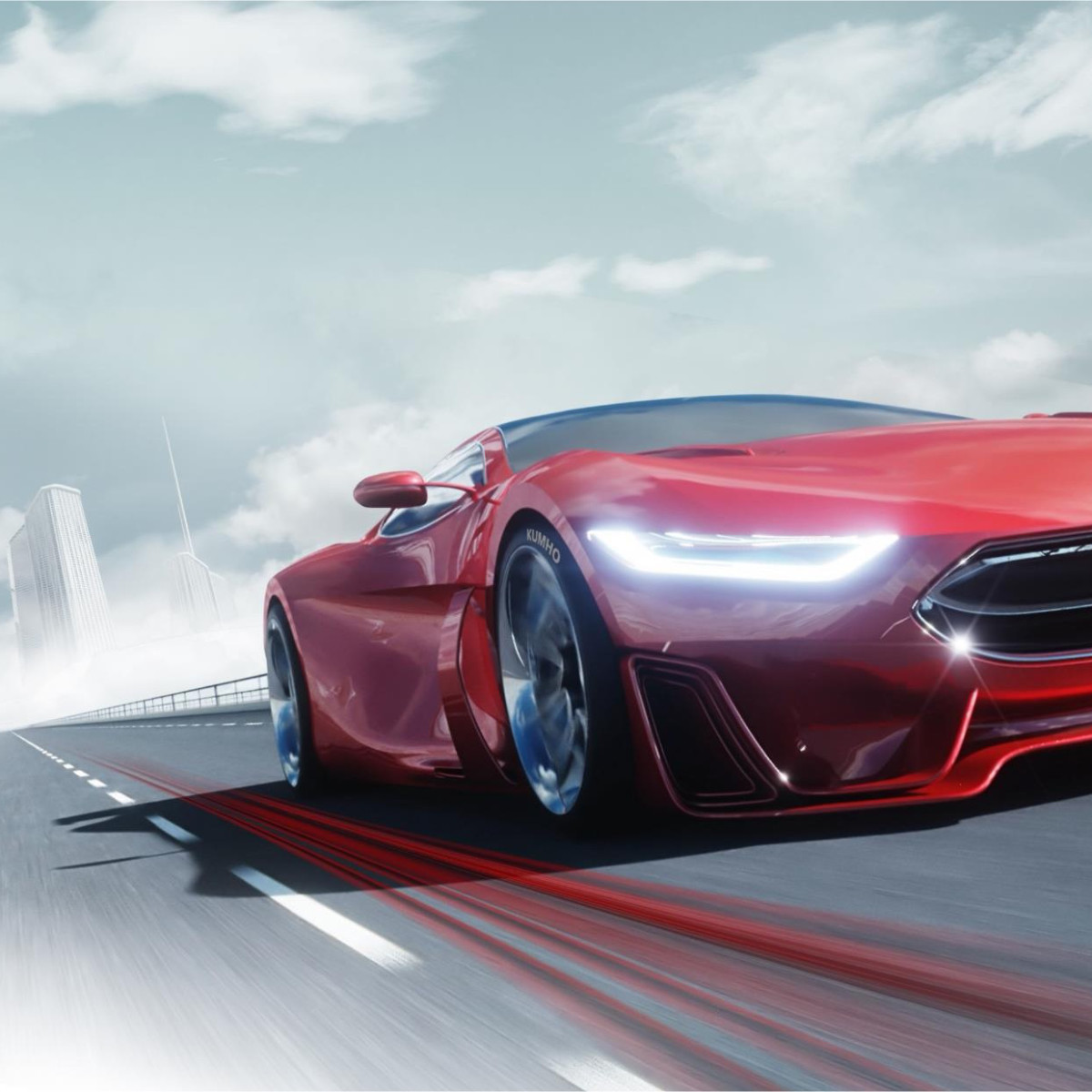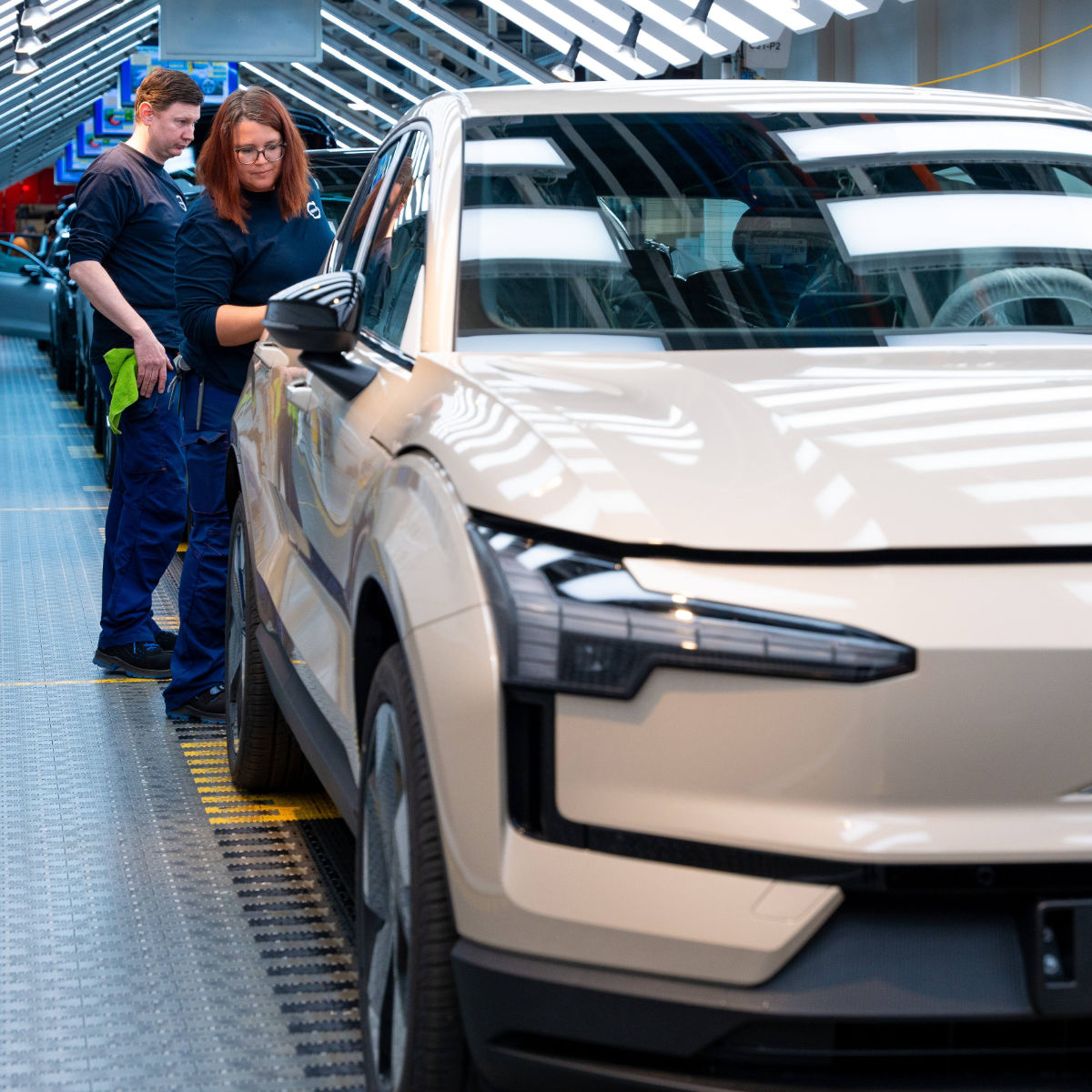Reading time: 12 minutes
The emergence of a leading market
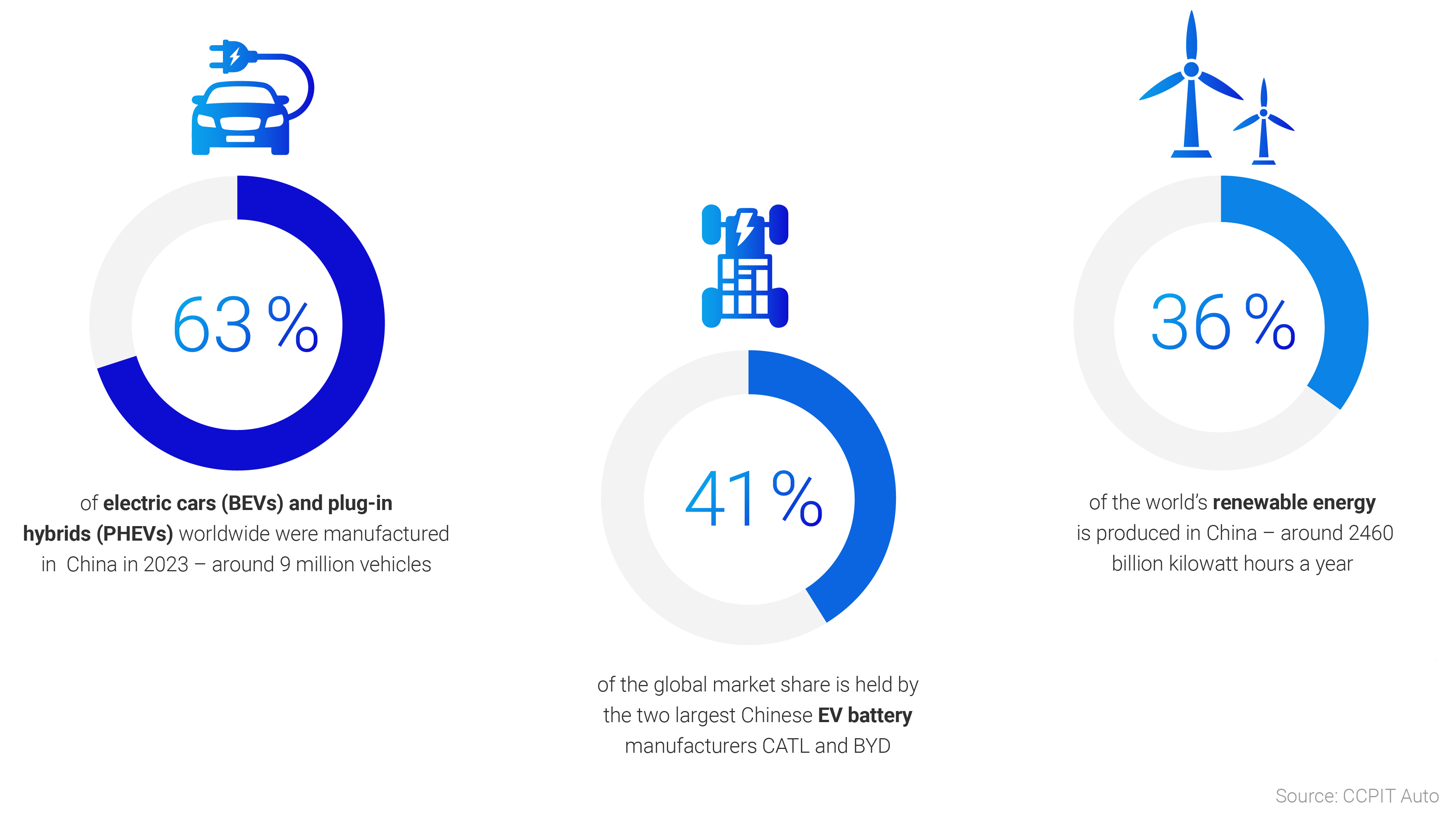
In just 20 years, China has electrified a significant proportion of its transportation and established a powerful NEV (New Energy Vehicle) industry. Currently six out of ten electric cars produced globally are manufactured in China. In China itself, it is estimated that 45 per cent of car sales in 2024 will be NEVs. The term NEV does not just mean ‘electric’ (BEVs and PHEVs, i.e. battery electric and plug-in hybrid vehicles), but also and Fuel Cell Electric Vehicles (FCEV). Another subsidised category is ICVs, Intelligent and Connected Vehicles, a category for which the NEV development plan outlines targets to be achieved by 2035 that align with the expansion of the 5G network. Thanks to its prioritisation of new technologies, China has managed to skip development stages (known as ‘leapfrogging’) as opposed to merely emulating established producers of combustion engines. By implementing pilot projects, purchase incentive programmes and subsidies, China has managed to establish itself as a global leader in electric mobility while also fostering the growth of value chains in the battery market. In addition to reducing emissions, its objective was also to reduce dependency on oil imports. Furthermore, the electricity used in electric cars will also become green, with the goals set as part of a five-year plan for renewable energies in 2022 gradually being introduced. By 2025, the proportion of renewable energy used is set to rise to 33 per cent. Every second dollar invested in renewable energies worldwide is invested in China.
Funding and the development of the industry
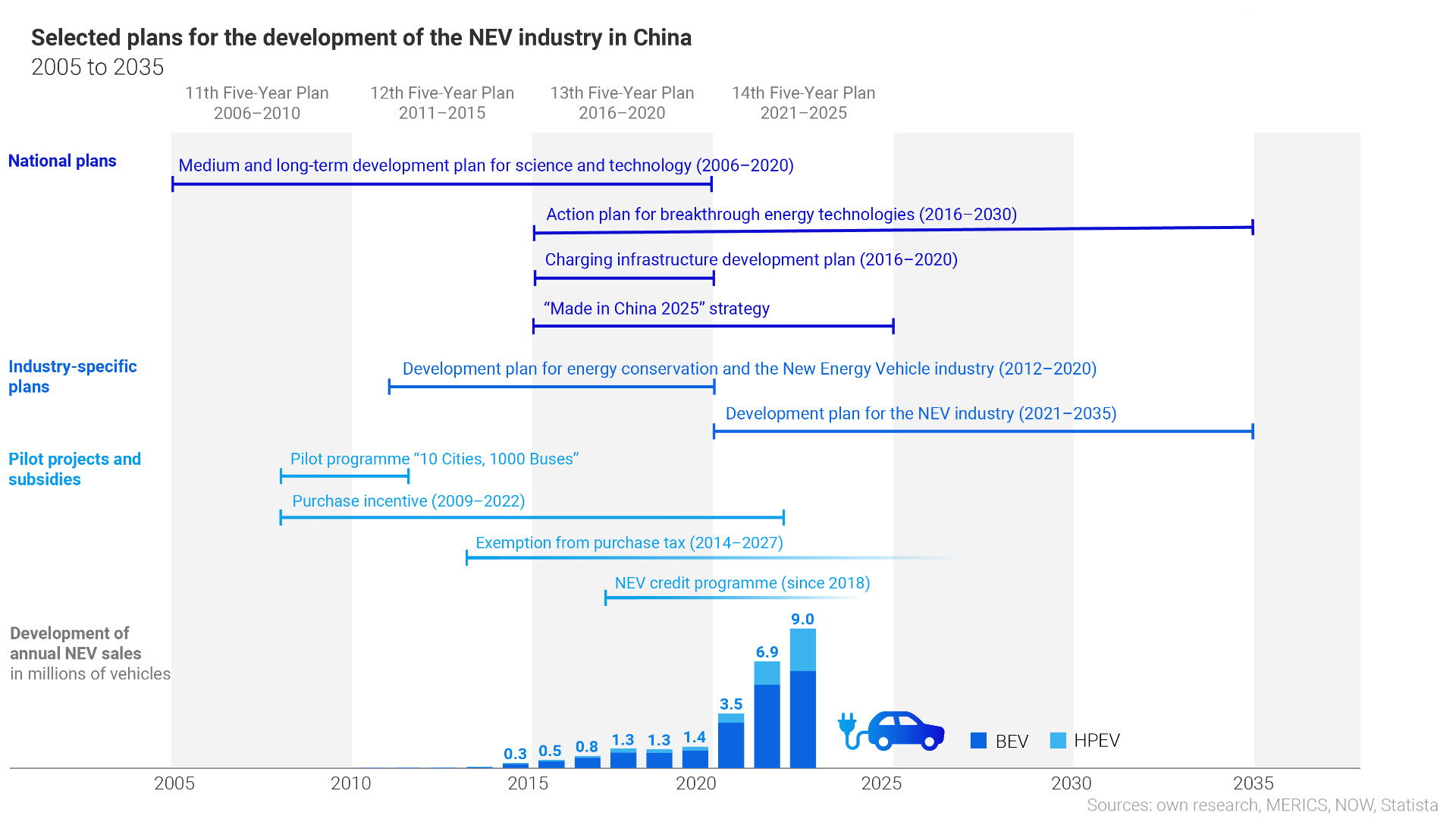
The country’s transition to e-mobility began in 2001 with initial investments in research and development as part of the ‘National Programme for the Development of High Technology’. This was followed by a host of plans and programmes, including the pilot programme ‘10 Cities, 1000 Buses’ in 2009, which was subsequently expanded to 25 cities, and the macro strategy ‘Made in China 25’, which identifies ‘energy conservation and electromobility’ as a key industry. Following the industry-specific plan ‘Development Plan for Energy Conservation and the New Energy Vehicle Industry’ of 2012, the second development plan for the NEV industry was launched in 2020 and remains in force today. These plans lay down the short, medium and long-term goals for market development, technological development and infrastructure. The most recent goals for the NEV industry include the promotion of ‘high quality development’ and integration of NEVs into the electricity grid. In addition to these ‘major’ targets, local governments have also set up programmes and initiatives in the provinces and in cities and municipalities, including offering subsidies. The fast pace of development is due to the fact that the electric engine is a comparatively simple technology. To manufacture a diesel engine, an average of six employees are needed, whereas just one is required in the production of an electric engine. An additional favourable aspect was the availability of several of the required raw materials within the country itself. China is now a leading global player in battery technology, building on its existing expertise in electrical engineering.

Another factor that plays into the success of e-mobility in China is that new registrations of NEVs in major cities are quicker and cheaper than for vehicles with combustion engines, which can take a long time to be registered because number plates in cities such as Shanghai, Beijing and Guangzhou are allocated via auctions and lotteries. Within the cityscape, it is easy to tell which vehicles are NEVs and which aren’t: NEVs have a green registration plate, while the combustion engine vehicles have a blue one.
The power of 100 companies

The Chinese NEV market is only just beginning to consolidate. Around 100 companies manufacture electric cars, with some of them offering multiple brands. Geely, for instance, produces approximately 20. The top 10 companies hold a combined market share of approx. 70 per cent, with the market comprising a mix of private companies such as BYD and state-owned entities like SAIC. They are located in China's economically strong, densely populated regions that offer a favourable climate and are in close proximity to the sea.

One striking aspect is just how far removed BYD Auto, which, like Tesla, was founded in 2003, is from its competitors. The reason behind this is that BYD started as a battery manufacturer, which means it has a lot of experience with the most complex and costly part of the electric car. The company has its own in-house battery manufacturing process and relies on strong vertical integration. As a result, BYD has integrated almost the entire automotive supply chain – the components it manufactures in house include engines, transmissions, steering and braking systems and the vehicle’s entire electronics, even down to the windscreen wipers, seat belts, airbags and CD player. Other Chinese manufacturers, however, also work with suppliers such as German companies like ZF.

The current competitive landscape in China comprises a broad spectrum of small and affordable vehicles with short ranges to very high-range luxury SUVs. Experts expect that by 2026, over 700 electric car models will be offered by China to the rest of the world. With over 200 electric car models on offer, Germany is currently the world no. 2 behind China. However, an important difference between the two is that more than 60 per cent of the electric cars offered in Europe are SUVs, whereas a significantly higher number of smaller electric cars are available in China.
Public transport goes electric
The electrification project does not just encompass privately owned cars, but also buses, taxi fleets and trams. One example is the pilot city and tech metropolis of Shenzhen in southern China, which is the first city in the world to have a fully electric public transport system. Since 2017, only electric buses (approx. 20,000 of them) have been used in the Shenzhen public transport system. The following year, taxis, transport services and emergency vehicles were converted to electric (approx. 24,000). The manufacturer of these public fleets is BYD, which is headquartered in Shenzhen. Autonomous driving and automated driving systems are also important issues here. The underground transport systems are already largely driverless. In 2022, Shenzhen passed the first comprehensive regulations for fully autonomous driving in China – ‘The Intelligent Connected Vehicles Regulation’. Since then, fully autonomous taxis by Baidu (‘Apollo Go’) have already been operating in some neighbourhoods – Baidu has recently also obtained operating licences to operate in Wuhan, Chongqing and Beijing. And the first mini fleet of 20 fully autonomous buses will arrive on the roads this year.
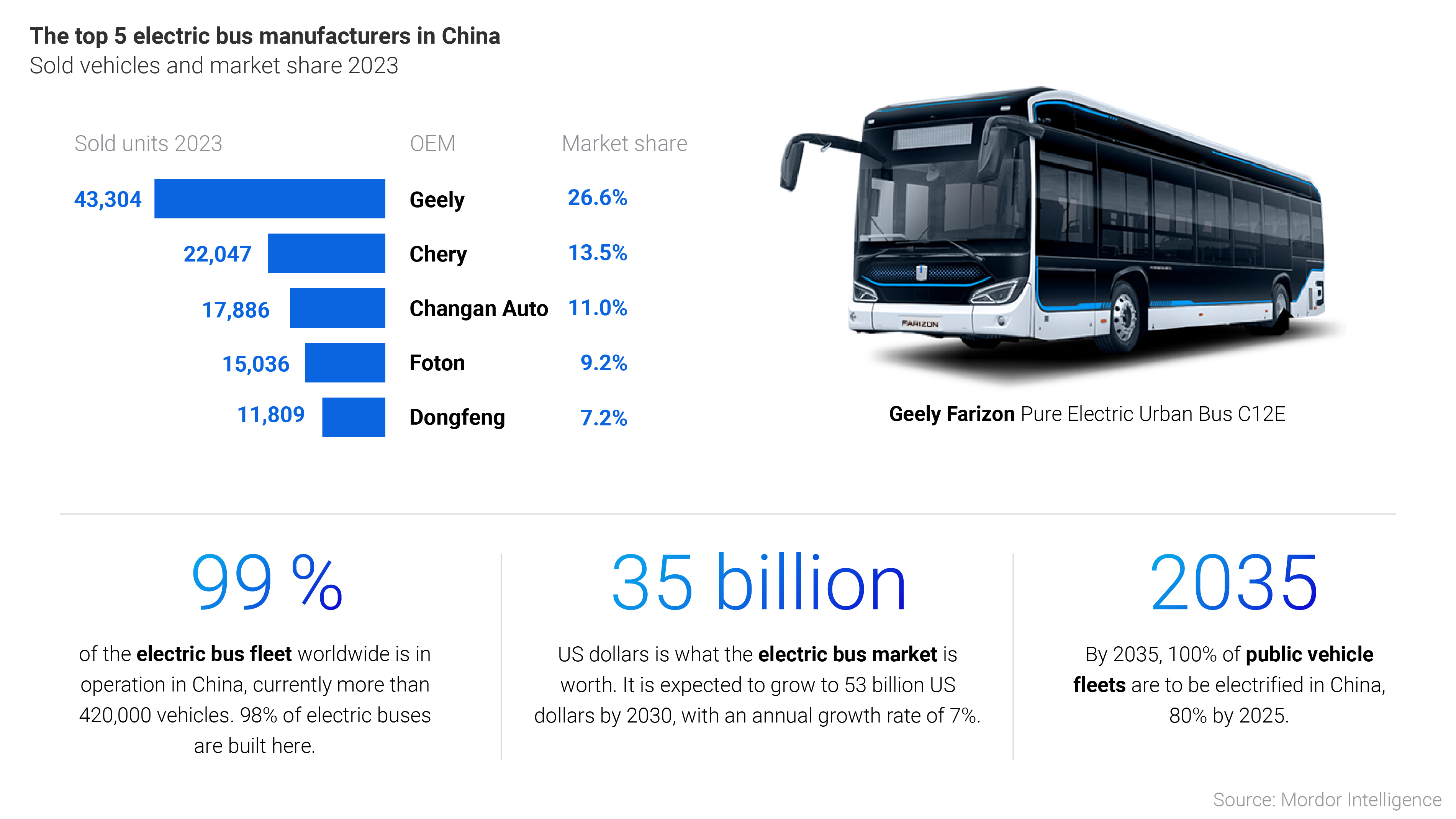
China dominates the global electric bus market. Across China, Geely is leading both the lorry and bus markets within the new energy sector. In 2023, Geely’s sales figures increased to almost 75,000 units of electric lorries and buses, triple the amount sold by the Chery Group, its biggest competitor. At Geely, Chery and Changan Automobile, the growth of buses with alternative drive technology can be traced back to the sale of smaller electric buses. In 2023, the overall size of the Chinese market for buses with alternative drive technology was around 160,000 units.
The revolution on two wheels

The first mass adoption of electric mobility in China was for bicycles, mopeds and motorbikes. Some of the larger cities such as Beijing, Shanghai and Shenzhen began to ban petrol mopeds from their city centres in the early 2000s, a move aimed largely at improving air quality. These measures were expanded in subsequent years, and many urban areas have now also implemented this ban. In China, electric mopeds are a very popular means of transport because they are well suited to transportation, not as strenuous to ride as the bicycle and the lowest category of mopeds do not even require the rider to have a driving licence. Every year, 40 million new mopeds hit the country’s roads, of which 80 per cent are electric. In 2023, dominant brands such as Tailg, Yadea, Aima and Green Source sold over 48 million units in 2023, comprising over 80 per cent of the market. The development of electrically assisted bikes has been an official goal since 1991. According to the China Bicycle Association (CBA), 700 companies are now active in the market, with the ten largest dominating more than half of production.
Brand sales and the aftermarket are merging
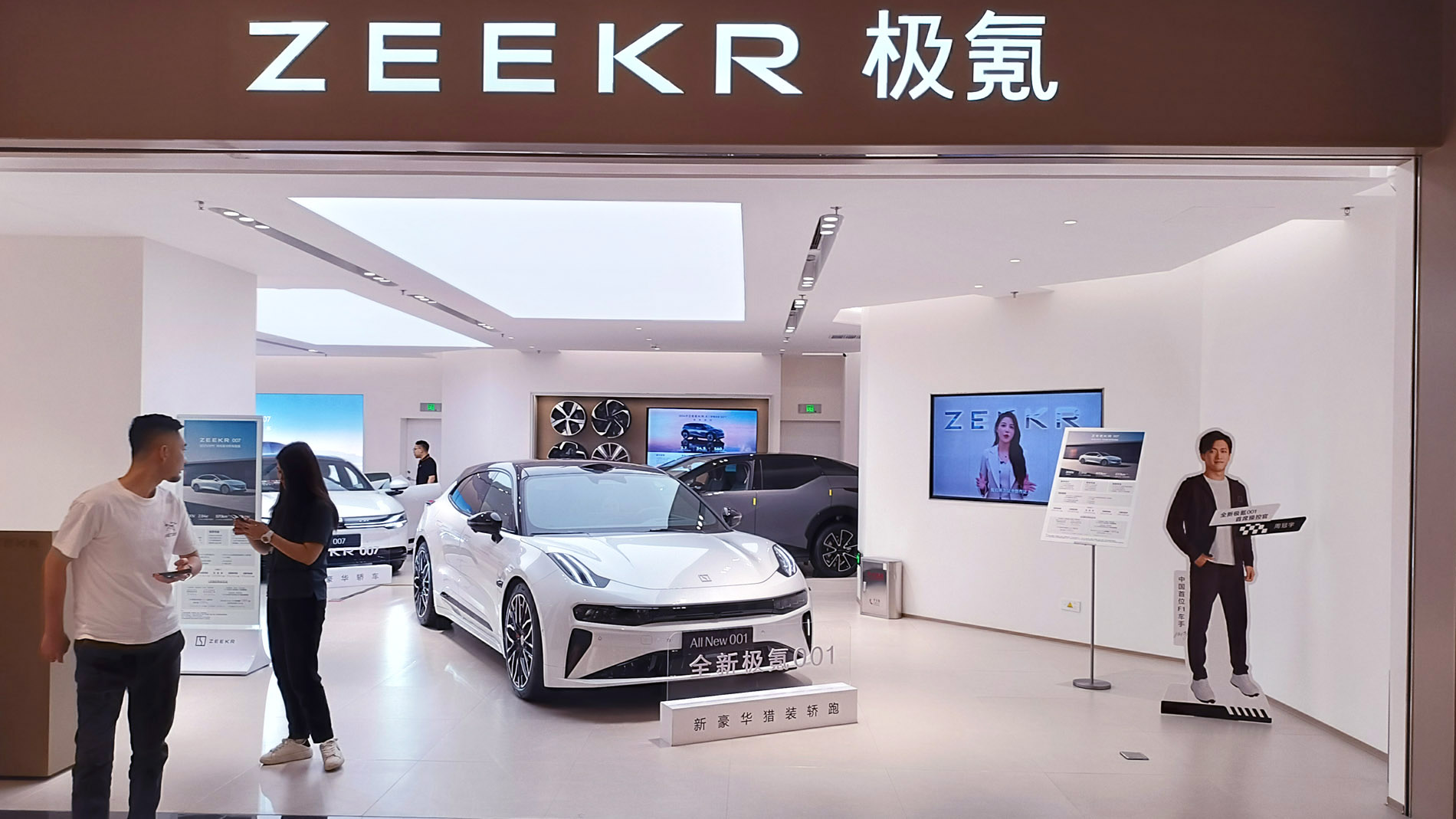
While in Germany, the ‘typical’ sales channel is a dealership on the outskirts of town, in China you very often see electric car manufacturer showrooms in the heart of city centres and shopping centres. In other words, the sale tends to come to the buyer rather than the other way round. Premium brands are also offering new combinations of flagship store and wellness oasis, such as the ‘Nio House’, a ‘community space that brings the brand world to life.’ Nio vehicle owners have exclusive access to this space, where they can drink coffee and attend events, plus take advantage of coworking and meeting rooms and a childcare facility. Nio is also collaborating with other luxury brands, which sell products designed for Nio in the Nio app under the ‘Nio Life’ label. The car thus becomes part of a lifestyle. The Chinese name Nio ‘蔚来’ (wei lai) literally means ‘blue sky is coming’ – an allusion to the use of e-mobility to solve the smog problem.

Comprehensive service and repair offers are also associated with these flagship stores, such as the BYD 4S stores, where you can relax while your car is repaired. 4S stands for ‘Sale, Spare parts, Service and Survey’, stores where brand sales and the aftermarket are bundled together. The 4S model has been around since 1998 and is used by several manufacturers. There is also IAM (Independent Aftermarket), which services cars whose warranty has expired for affordable prices.

The ‘fun of driving yourself’, which is important in marketing in Europe and the USA, does not play as great a role in China. As Chinese consumers often use drivers in major cities such as Shanghai and Beijing, and they spend a lot of time stuck in traffic jams, they prefer comfort in their cars, as well as a good entertainment system and good service. Consumers are also willing to try out new sales models. The Swedish-Chinese Lynk & Co. that is offered by Geely is one such example. This aims to appeal to younger customers and offers cars on a subscription or leasing basis. Sales take place in ‘clubs’ with coworking spaces, where people can drink coffee and which sometimes sell sustainable clothing.
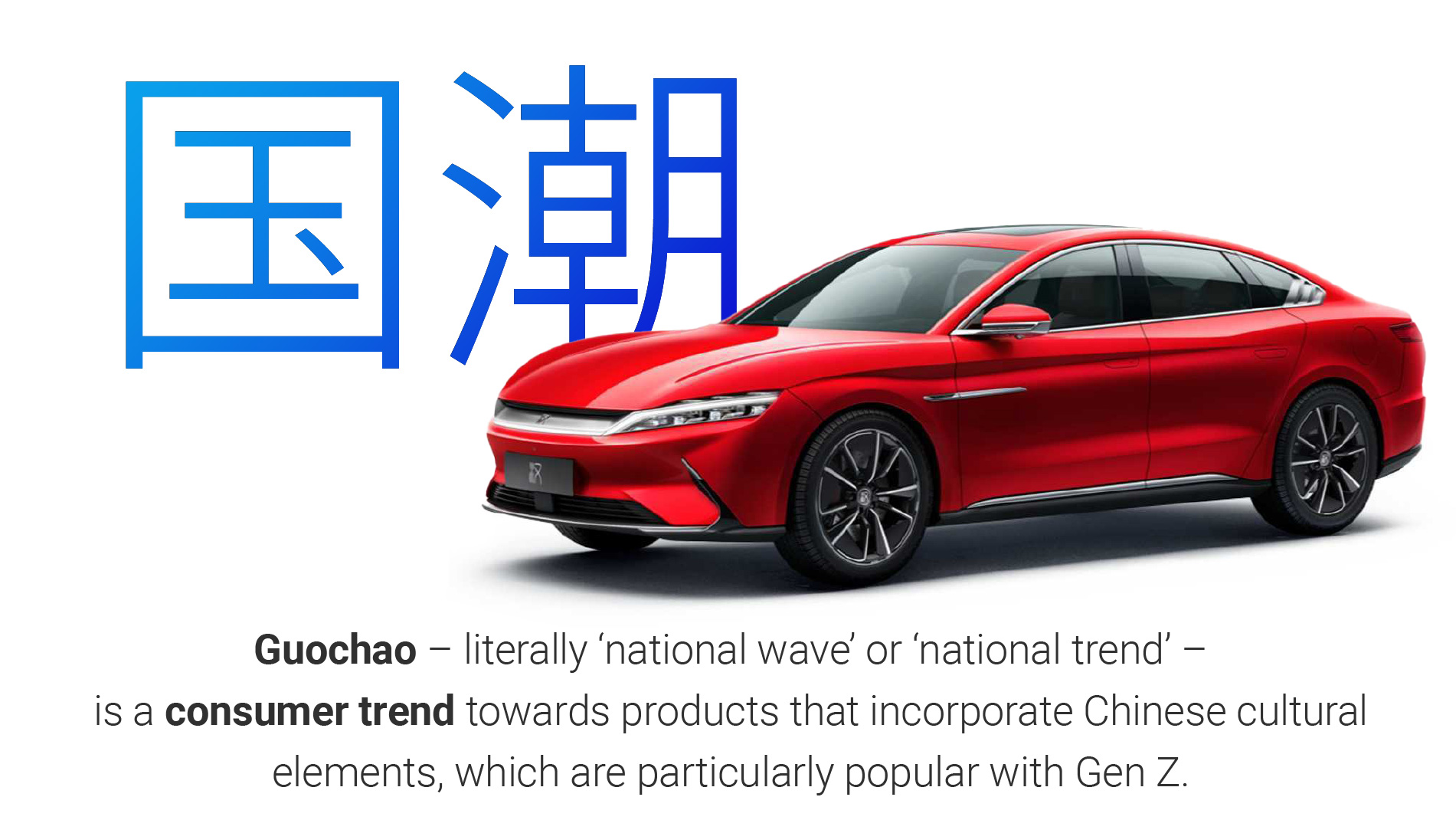
The ‘Guochao’ (国潮) trend has been popular in the luxury goods segment and amongst Generation Z for a few years now. The term can be translated as ‘national wave’ or ‘China Chic’ and refers to the fact that young Chinese are keen to buy products made in their country, provided they embody the national identity and incorporate traditional cultural elements in their design. When it comes to cars, this is represented by the mid-range saloon, the BYD Han from 2020 – called 汉/Han after the Han dynasty, now the largest ethnic group in China. Traditional elements on this model include the red colour, a ‘dragon face’ design language and references to decorative Chinese knots in the rear lighting. The head designer of BYD since 2016 has been a German, Wolfgang Egger, who previously worked for Alfa Romeo, Lancia, VW and Audi.
Seamless connection between car and smartphone
Chinese buyers want autonomous, intelligent cars. There is extensive digitalisation in China and people organise almost all aspects of their lives via smartphone. Overall, people are keen to take advantage of new technological opportunities, giving rise to corresponding demand in the automotive sector. ‘The expectations Chinese customers have of electric cars are very different to those in the rest of the world,’ Nissan CEO Makoto Uchida remarked at the Financial Times' ‘Future of the Car Summit’ this May.
“Young people in China no longer see electric cars as just vehicles, but want them to work just like smartphones.”
To this end, partnerships with technology companies such as Alibaba, Baidu, Huawei and Tencent are helping Chinese car manufacturers to implement innovative solutions more quickly and effectively. In recent years, major telecommunications companies such as Huawei and Xiaomi have also entered the automotive industry, with their vision being to foster seamless connections between electric cars and smartphones. Geely has bought shares in smartphone manufacturer Meizu and installed their software in its own cars. Conversely, Nio, an electric car manufacturer, has launched its own smartphone on the market.

China’s NEV development plan until 2035 focuses specifically on promoting the development of intelligent and connected vehicle technologies. In November 2023, the government announced a pilot programme that will put more autonomous vehicles on the roads and accelerate the commercialisation of this technology. While cars by manufacturers Xpeng, Huawei and Nio do not yet offer fully autonomous driving, they do offer driver assistance systems. Level 3 and 4 autonomous cars will now be permitted in specially designated regions, provided manufacturers fulfil certain requirements. Tech giant Baidu, which offers the most important map service in China (similar to Google Maps), and Geely founded the premium brand Ji Yue (极越) in 2023 as a joint venture, which are launching intelligent sporty ‘Robocars’ on the market. The Chinese electric car manufacturer Xpeng announced that it would hire 4000 new staff in 2024 and invest 480 million US dollars in artificial intelligence. In doing so, it wants to survive, as it puts it, the ‘bloody sea’ of competition in the largest car market in the world. BYD, which was previously not a leader in this field, announced in January 2024 that it would invest around 14 billion US dollars in AI-supported functions for its vehicles, including improved voice recognition and automatic parking.
The Electric Vehicle Expo at Automechanika - EVA - in Hall 12.1 will feature Chinese manufacturers of electric vehicles. Trade visitors will have the opportunity to get to know the manufacturers and explore opportunities for cooperation.

